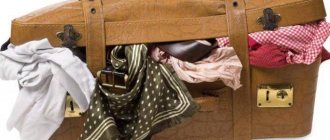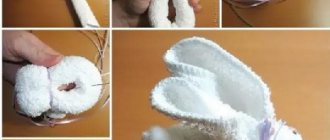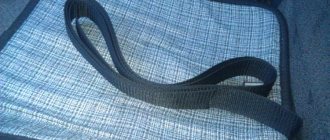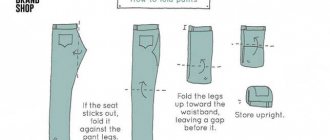Seasonal clothes keep you warm during cold, rain and snow, but take up a lot of space in your closet and on hangers on hot days when not in use. If you fold your jacket compactly for the warm season, you can free up space for everyday things, ensuring comfort, cleanliness and order in your home.
Proper organization of free space in the closet helps to maintain order in the house
What we have, we take care of it
While there are differences in how you store lightweight skirts and T-shirts or fall jackets, there are basic rules that can help maintain the appearance of items stored away for a long time.
Before you pack up your outgoing season's outfits, clean them of any traces of use. Dry clean jackets, hats, coats, down jackets and other outerwear; wash and dry the rest thoroughly. Ventilate cabinets and chests of drawers once every two weeks, but do not expose them to bright light, especially sunlight. During this time, remove pets from the rooms: no matter how touching cats may be when they fall asleep on a stack of sweaters, the traces they leave behind will not please anyone. Using plastic containers or cases will help store clothes compactly, protecting them from pests and dust. They make sorting easier and are simply irreplaceable in closets with deep shelves, where otherwise there is a mess from mixing piles from the first and second row. Heavy things are always placed at the bottom, and light and fluffy items occupy the top of the shelf or box. This is how clothes made from thin fabrics that can stretch after several weeks of immobility are stored. Anything that loses its shape when folded is hung in the wardrobe
You need to pay attention to the size of the hangers so that clothes do not slide off too small hangers and are not stretched by hangers that are too large. Ideally, each item should hang separately; in extreme cases, you can hang lighter shirts on top of heavier ones. In addition to protection from shape distortion, you need to think about protection from dust and moths
You can throw a cotton shirt over jackets or windbreakers or cover them with a special plastic bag. When choosing how to store a down jacket, leather jacket or fur coat, give preference to canvas or paper covers. Plastic is not suitable here, since natural materials must “breathe”. Vacuum bags for clothes save space, but they hopelessly spoil the fur and leave creases on the skin, and it is very difficult to restore the air gap in the crumpled filling of a down coat. Naphthalene, which smells bad and is dangerous for children and animals, has long been replaced by aromatic sachets. The smell of lavender or sage also repels moths. Bunches of these herbs in the closet, bags of them in dresser drawers, or cedar balls and sticks placed between clothes will protect you from unexpected guests. When laying them out, you need to make sure that they do not come into direct contact with things, wrap them in tissue paper.
How to store fur and leather items
Fur products are extremely finicky and require special care. Ideally, coats made of natural fur - mouton and mink - should be stored at a temperature of 0 to 10 degrees, but it is difficult to ensure such a temperature at home. Therefore, it is necessary to give fur products a place in the built-in closet on the loggia, where there is coolness and no moisture.
First, you should prepare your fur coat or sheepskin coat for long-term storage, for example, take it to the dry cleaner or clean the items yourself at home
Vacuum the fur, go over the fur coat with a special brush, then hang it on a wide (this is important) hanger (preferably made of natural wood)
After this, treat the fur with a moth repellent, especially paying attention to the area under the hood and on the sleeve cuffs. Pack the fur coat for storage in a fabric case and hang it in a cool, dark place
To add a pleasant aroma, put a bag of lavender in your fur coat pocket.
Before packing, it is better to treat the sheepskin coat with a special product for the care of suede products, and a swab soaked in a solution of 1 tsp will help remove dirt. 9% vinegar per 1 liter of water. After processing, the sheepskin coat should dry and ventilate. A fabric bag and a hanger with wide hangers are also suitable for storage.
A hat made of natural fur must be cleaned and put on a round object so that it does not lose its shape. This could be a jar, a wooden block, or stands made from newspaper tubes.
If you don't have any of this, you can stuff the hat with paper.
Leather gloves should also be put on a form cut out of cardboard so that they retain their original appearance and do not develop creases or abrasions.
Let's part with the past
There are subtleties in storing summer or winter things, but you always need to start with strict sorting. A stream of clothes bursting out of the closet looks untidy. But the things themselves quickly lose their shape and attractiveness. Therefore, at the end of the season, looking at your wardrobe, honestly answer the questions:
- whether you will wear these clothes in a year;
- will you wear a stretched T-shirt;
- Will the sweater still be useful if I mend a hole in the sleeve? And will you sew it up;
- the dress is hopelessly small, will you have time to lose weight before it goes out of fashion;
- Will you finally take up patchwork, or will this mountain of old shirts fall through the cracks for another year?
Anything that has not received a positive response, mercilessly send it aside, give it to someone else, or simply throw it away. Some rigor in solving the problem of “nothing to wear, nowhere to put it” will be rewarded with freed up space for new clothes. This will help to better preserve the remaining things.
Rules for folding jackets made of various materials
When packing things in a suitcase or for long-term storage in a closet, be sure to take into account the material of the product. Leather items, fur coats, fur coats and sheepskin coats can especially suffer from improper storage. Down jackets are less capricious, but they can also develop signs of bruising that will be difficult to remove.
How to fold a leather jacket
An expensive item will last a long time and will not lose its original appearance only if it is properly cared for. Leather jackets are a status item of clothing; they are treated with a special cream, wiped, dried and carefully stored.
It is better not to fold or roll a product made of genuine leather, as this will prevent creases and dents from forming on it. It is recommended to place the jacket in a fabric cover and hang it on hangers in the corner of the closet. But sometimes a leather jacket needs to be folded compactly for transportation. The sequence of actions is approximately this:
- Fasten the jacket with a zipper or buttons.
- Turn the product inside out.
- Place the sleeves crosswise on the back.
- Place the hood on top of the crossed sleeves.
- Wrap the leather jacket as tightly as possible.
- Place the folded item in a fabric bag so that the item does not get dirty in transit.
Attention! If during transportation a leather jacket becomes wrinkled or creases appear on the material, do not be upset, the item can still be saved. An expensive item of clothing should be hung on hangers in the bathroom and the hot water flow should be turned on.
Steam and humidity will help straighten out your leather jacket and restore its attractive appearance.
It is necessary to lay a bulky item compactly on a horizontal surface
How to fold a synthetic jacket
It is recommended to fold warm winter clothes into a rectangle for storage in the closet - this way they will take up less space and free up space for summer clothes. The compact method involves the following procedure:
- Place the jacket on a flat surface facing away from you.
- Place the sleeves on the back and cover them with the hood if it cannot be detached.
- Fold the product in half so that the bottom and top are on the same line.
- To be secure, secure the item of clothing with an elastic band and put it on the floor in a closet.
It is convenient to take thin down jackets or padding polyester vests with you on the road. The item is laid out on a flat surface, then turned over and the sides are folded towards each other. Next, the vest is folded four times and rolled into a compact roll.
How to fold a denim jacket compactly
A lightweight windbreaker made of universal material should not be put away on the far shelves of the closet. This item of clothing can be worn on cool summer evenings, warm spring or early autumn. They wear denim even under a warm down jacket or coat.
You usually need to pack an item compactly for travel, for a bag or suitcase. Step by step process:
- Fasten the jacket with all buttons or a zipper.
- Lay on a horizontal surface with your back to you.
- Fold the sleeves over and fold them parallel to each other.
- Fold the bottom of the product and level it along the top line, slightly bending the jacket's tails inward.
Denim fabric practically does not wrinkle, so you can fold the product to the very bottom of the suitcase, placing other things on top of it. For transportation in a backpack, it is best to roll up a denim jacket tightly.
Compact fold denim jacket
Tags
5 things and bulky things took a few things flat folded things. such things correctly. the right thing. expensive things from wrap up a jacket like fold a jacket fold a jacket fold a jacket into fold a jacket fold a jacket a leather jacket a synthetic jacket a denim jacket fold a jacket leaving the hood. with a hood with a hood with a hood inside the hood. Put the hood How to fold a winter jacket If folded, you can fold them a stack of folded ones so compactly fold a jacket will fold several, you can fold very horizontally folded things. lie compactly. way to fold compactly How to fold compactly How to fold compactly How to fold compactly How to fold compactly
Features of storing jackets
In a large family, the lack of free space is especially acute. Each adult usually has 2-3 jackets for the season, plus children's clothes, which take up space no less than the clothes of mothers and fathers. Before packing your jackets compactly for the winter, it is recommended to do the following manipulations:
- Check the general condition of the clothes: sew on torn buttons, fix broken zippers, shake out small debris from pockets.
- Wash or dry clean the jacket and dry thoroughly. It may be worth going to a dry cleaner to avoid ruining expensive items made from delicate fabrics.
- It is best to try to sell damaged or unsuitable clothes or give them away to someone free of charge, so as not to take up free space in the house.
For long-term storage, the item must be absolutely clean and thoroughly dried.
It is important not only to fold the jacket compactly for storage, but also to control the conditions in which it will be kept for several months. Fur items are afraid of moths and other pests; creases may appear on the skin from improper storage
Poorly dried product material can lead to mold ruining the jacket.
Each material has its own storage characteristics:
- Jackets made of natural fur. It is best not to wash such clothes, but to clean them dry. Treat the product with special products or an aerosol against pests. Instead of poison, you can use natural cedar oil. It is best to store a fur coat or fur coat on hangers in a fabric cover, which will ensure air circulation and prevent the clothes from acquiring a musty smell.
- Leather items. These jackets also have natural fur inside, so the product should be treated against moths. There are special products that soften leather products and prevent the formation of creases on the delicate material.
- Voluminous jackets and down jackets. Synthetic items do not have to be hung on hangers and placed in a fabric case; a simple bag from which the air must be pumped out will do.
You should learn how to fold jackets correctly so as not to spoil them and free up as much space as possible in your closet, bag or suitcase.
Storing bulky items in vacuum bags
Location of product pockets
The location of the chest and horizontal welt pocket of a jacket and coat
Chest pocket with leaflet. To design a chest pocket with a leaf, take the shelf of the product at the stage of modeling the style. From point G along the armhole line, set aside ГГ1 = 1/4 of the Armhole Width according to the drawing minus 0.5 cm. Depending on the size of your product, the resulting value can be from 2.5 to 6 cm. Г1Г2 = 1.5-2 cm.
The width of the leaflets can vary depending on the size from 2 to 3 cm (G3G4 = 2-3 cm). The length of the entrance to the chest pocket for size 48 is:
- for a jacket - 10.5 cm
- for a coat - 11.5 cm. For adjacent sizes, the length of the pocket entrance changes by ±0.3 cm.
Rice. 7. Location of jacket and coat pockets - chest and horizontal welt
Position of the horizontal welt pocket. To determine the position of the horizontal welt pocket relative to the waist line, use the DTS measurement (Length to Back Waist). From point T, move down vertically:
- For a women's jacket TT1 = 1/4 DTS - 4 cm (may vary slightly both up and down).
- For a women's coat TT1 = 1/4 DTS - 3 cm (may vary slightly both up and down).
From the right side of the waist dart, set aside CC1 = 1.5-2 cm to the right.
The length of the horizontal welt pocket K1K2 (the length of the entrance to the pocket) is calculated according to the measurement Bust circumference: K1K2 = 1/10 OG + increase:
- The length of the pocket entrance for a women's jacket K1K2 = 1/10 OG + 5.5 cm (in designer models the number can vary both up and down).
- The length of the pocket entrance for a women's coat K1K2 = 1/10 OG + 6.5÷7 cm (in designer models the number can vary both up and down).
The standard width of the welt pocket frame is 1.5 cm, but can be from 1 to 2 cm if desired.
The location of vertical and inclined welt pockets of a jacket and coat
Often in products you can find vertical or inclined welt pockets with a leaf or a flap. Such pockets are modeled as follows. From the auxiliary line for constructing the armhole of the front (point G) and from point C.G. (Center of the chest), lower the perpendiculars down until they intersect with the waist line - points T and T1 are obtained. Distance TT2 = 1/2 TT1.
- For models without a belt T2K = 2-4 cm.
- For models with a belt, calculate the T2K distance using the formula: T2K = 1/2 Belt Width + 2 cm.
How to fold a jacket
The techniques for packing a jacket, regardless of where you plan to store the product, will differ only if the outerwear is made from different materials. For example, for a down jacket this is one technique, but for leather it is completely different.
How to fold a winter jacket compactly
There are several ways to help compactly fold winter outerwear for off-season storage. Each of them is quite simple and convenient. They can be:
- roll into a roll;
- fold into a rectangle;
- place in a vacuum bag.
Roller
The easiest way is to carefully roll the item into a roller. What is needed for this? Unfold the product completely on a flat surface. Close the locks. Turn inside out, including the sleeves. Next, straighten your clothes to prevent the formation of deep creases. Then fold the sleeves crosswise so that the cuffs are near the waistband. Now fold the jacket in half vertically, that is, folding it in the center (at the zipper). Starting at the bottom, roll the garment into a tight roll. To fix it in this form, you can use rubber bands. If you don’t want dust to settle, additionally place it in a bag made of natural fabric to allow air access.
Rectangle
Folding into a rectangle involves slightly different actions. This method is suitable if you are going to put the product in a suitcase or a drawer in a closet
It is very important that the rectangle is even. For this:
- Place the item face down on a flat, hard surface;
- roll up the sleeves along the side seams at the back;
- fold along the center;
- connect the lower part with the upper;
- secure with an elastic band and pack.
Vacuum package
But the use of vacuum bags is not suitable for every clothing. For example, it is undesirable to use this type of packaging if the jacket is made of leather or contains elements of it, or has a fur trim. However, this method is quite convenient, since the vacuum saves a lot of space.
This is quite important if storage space is limited. How to store a jacket in a vacuum bag? It is enough to fold the product using one of the methods described above and then place it in polyethylene
Next, you need to tightly close the special fastener and use a vacuum cleaner or pump to extract all the air using the valve.
How to fold a jacket with a hood
Folding a jacket that has a hood can sometimes be a hassle. And it’s good if you can simply unfasten it, then there will be no problems. But what if it is firmly sewn? There is an exit! And he's quite interesting. The jacket just needs to be rolled up... into this very hood.
What is needed for this?
- fasten all zippers and turn the product inside out;
- the sleeves need to be folded one on top of the other;
- start rolling into a roller, starting from the bottom (do it as tightly as possible);
- Once you reach the top, place the roller inside the hood, having first straightened it.
Using this method, a rather small roll is obtained from a bulky down jacket, which fits perfectly on a shelf even in the smallest closet.
How to fold a denim jacket compactly
In fact, folding a thin jacket is much easier than it seems at first glance. Moreover, there is a fairly simple way so that later it fits compactly either in a suitcase or on a shelf in a closet.
To do this, you need to unfasten the buttons or zipper, turn the jacket with your back to you and, leaving it hanging, turn the sides towards you. This way, your sleeves will remain inside, but the product itself will be turned inside out. Next, lay it out on a hard surface and align the seams. Now all that remains is to fold it vertically and turn the bottom to the top.
Did you buy a windbreaker?
If you turned the pockets of your light jacket inside out several times, but did not find any elastic bands inside, think: maybe you didn’t buy a windbreaker at all? Before you go shopping next time, find out the main features of this type of clothing.
So, a real windbreaker should be made of waterproof material, which at the same time can protect from the piercing autumn wind. It must have a straight silhouette. Sometimes, usually in women's models, a slight fit is allowed due to the elastic sewn along the waist line.
The cuffs and bottom of the product must be tightened with elastic bands. There are always side pockets with fasteners. There may be an additional pair of patch pockets on the chest - but this is not at all necessary.
The collar is usually made stand-up. Another mandatory attribute is a hood, which is attached to the jacket with a zipper, Velcro or fastened with buttons.
Now you have learned how to put your windbreaker in your pocket and can safely go on a trip through city streets, to the stadium or into nature. And a compactly folded windbreaker will always be there to protect you in case the weather suddenly turns bad.
Source
Application of covers and vacuum bags
Special devices for proper storage of things have become very popular among consumers. These are covers and vacuum bags. Their application is universal. Cases help:
- maintain the shape and appearance of things;
- protect things from sunburn and damage;
- prevent stains on clothes.
Separately, it is necessary to say about vacuum bags. They are highly durable and, in addition to the qualities listed above, contribute to compact storage of clothes. This is achieved by pumping out air from inside the bag through a special valve on its surface. At the same time, the products inside do not wrinkle. Jackets packed in a vacuum bag take up minimal space, saving a lot of closet space.
Skillfully organized storage will help preserve winter clothes and extend their service life for a long time. By putting into practice the methods of folding down jackets, warm and leather jackets, you can significantly improve the packaging and reduce the load on dressing rooms, closets and suitcases to a minimum.
Might be interesting
The ability to correctly fold a sweater for storing or transporting a product will preserve its appearance,…
The rules regarding how to fold trousers directly depend on the material from which the item is made...
Anyone who has had to pack can attest that the hardest thing to fold is a shirt without it...
Seasonal clothes keep you warm during cold, rain and snow, but take up a lot of space in your closet and on hangers on hot days when not in use. If you fold your jacket compactly for the warm season, you can free up space for everyday things, ensuring comfort, cleanliness and order in your home.
Useful tips
In order to keep warm clothes as long as possible, it is recommended to purchase special covers for clothes. This versatile item helps maintain the shape of bulky down jackets and protects them from fading, dirt and other damage. There are special covers that are impregnated with a composition against insects and moths.
Storage bags can be fabric or vacuum. The latter are highly durable and compact. A bulky piece of clothing is placed in a bag and all the air is pumped out through a special valve. This method significantly saves space and helps preserve the item for as long as possible.
Children quickly outgrow outerwear. It is worth considering whether it needs to be stored until the next season or whether it is better to give the item to acquaintances, friends or close relatives who have small children.
Many bulky items cannot be washed by hand or in a washing machine. In order not to spoil a delicate item, you should have it dry cleaned by professionals.
How to compactly fold a jacket into a suitcase
In this way, you can not only compactly fold the jacket not only into a suitcase, but also for off-season storage. What is needed for this:
- Fasten the zippers or buttons and place the front part facing you.
- Now turn the bottom of the product inside out approximately 20 cm.
- Next are the sleeves. We fold them lengthwise, one on top of the other. If there is a hood, then we also lay it down, that is, we wrap it down.
- Next, fold it in half. Press down a little to let the air out. It is not necessary to press hard on the product. It is enough for it to “deflate” at least a little.
- The last stage is to carefully unfold the item and place the part of the bottom that was turned inside out on top.
- Ready! Clothes are ready for storage or transportation.
These are all the ways you can neatly fold your outerwear. They may seem complicated at first glance, but if you practice, then the whole process will take you no more than 5 minutes, and the result will pleasantly surprise you - when the time comes to take out the jacket, it will still look neat and tidy.
When going on a trip or packing things for off-season storage, many are interested in how to fold a jacket compactly? The volume of a suitcase or dressing room is not dimensionless, so it is important that clothes take up a minimum of space. This is especially true for jackets
Any neat person tries to pack clothes for storage and transportation so that they remain beautiful and do not wrinkle. There are many ways to fold things that will save closet space and space in your suitcase, and also prevent wrinkles and creases in the fabric.
Dress
Read also: Red short haircuts: new photos
Today, there are many styles of women's dresses. For this reason, the ways to put them in a suitcase are also different:
- Simple dresses with straps can be styled similarly to classic suit trousers.
- Dresses with hangers and sleeves are folded similarly to jackets and shirts.
To save space in your suitcase and to avoid creases, simple dresses should be rolled up. Upon arrival, it will be enough to hang them on hangers.
How to fluff a down jacket after storage?
Compactly folded outerwear can retain its given shape for a long time. It happens that the down jacket becomes very thin and wrinkled. But don't worry ahead of time. Usually it is enough to shake it well a few times and hang it on a hanger. Over the next 2 days, the insulation will absorb air and the fabric will smooth out. If this does not happen or you need outerwear urgently, you can fluff up the insulation in a short time. The following methods will help:
- Steaming. The jacket will smooth out best and fastest when treated with steam. Treat it with a special steam generator or an iron with a steam function. The device must not come into contact with the fabric. It is only necessary for the steam to penetrate inside the jacket and fluff up the insulation.
- Bathroom method. If there is no device that generates steam, you can use steam from hot water. Hang the down jacket on hangers in the bathroom, run a full bath of hot water and leave the item behind the closed door for 30–40 minutes. It is best to place the jacket directly above the water.
- Knocking out. To fluff up a natural down jacket after storage, you can use a carpet beater. Hang the jacket on your hangers and give it a good tap on all sides. Shake it and evaluate the result.
- Exposure to cold. Everyone knows that frost is good for fur products. In the cold, the hairs smooth out very quickly and become fluffy. Sub-zero temperatures have a similar effect on natural down and feathers. Try taking the down jacket outside or onto an unglazed balcony for 15–20 minutes. Shake the product vigorously several times. Soon the down jacket will fluff up and become voluminous again.
- Dry cleaning. If the jacket is heavily caked and, moreover, dirty, it is best to turn to professionals. They will help restore its original properties and appearance using chemicals, steam generators, special products and machines.
Patch pockets
We will show you how to properly process rectangular, round and pointed pockets. To get the perfect shape for the bottom of the pocket, we recommend making a template from cardboard and tucking the edge with it. You will find a detailed description of this method in our master class.
Another option for a patch pocket is with an oblique (slanted) entrance. Its top edge can be made with a narrow hem or with a full-cut facing, and we will tell you in detail how to do this.
The corners of the pockets may tear over time, so we recommend further strengthening them with decorative stitching. Most often this is done with small triangles at the end of the main stitch or with a tight zigzag bartack.
We will show you how to sew patch pockets to the main product using a sewing machine, but in some cases, if the design of the model requires it, they are sewn manually using a “back needle” seam (simulating machine stitching) from the wrong side. The fabric of the product is sewn with the bottom edge of the pocket hemmed so that no stitches are visible from the front side.
So, let's learn how to sew patch pockets!
Patch pocket with full-facing top edge
Fold and iron the top edge of the pocket. Stitch to the edge.
Fold the top edge along the fold line and stitch along the sides. Trim the allowances.
Turn the top edge over and press.
Prepare a cardboard template, excluding allowances.
For a pocket with rounded edges, baste coarsely in the corners, 5-7 mm from the edge.
Insert the template under the top edge. Fold the seam allowances to the shape of the template and iron. For a square pocket, first fold the seam allowance at the corners diagonally. Then fold in the sides. The pointed pocket is folded in a similar way.
Pull the seam allowances of the round pocket using the basting.
Distribute the gathers evenly and make cuts, if necessary, not reaching the edge by 2-3 mm. Take out the template, iron and baste again.
From season to season
Difficulties in storing out-of-season clothing often arise when it comes to woolen and knitted items, outerwear and hats. A few months in the wrong position can terribly ruin the shape of a cardigan or an expensive mink hat. Let us consider separately the features of storing certain types of things.
How to store hats and caps
It’s easy for lovers of woolen hats: put your winter friend in a bag and forget about it until the next cold weather. But where and how to store fur hats in the summer is a more serious question. Fur products need to be protected not only from moths, dust, moisture and bright light, but also from squeezing.
Hats are put on a special blank and placed in cardboard hat boxes. Instead of a blank, you can use crumpled newspaper, but do not stuff it too tightly. Even if the lid of the container does not sag, resist the temptation to stack a tower of boxes: there can be at most one more packed hat on top.
You need to store your coat correctly
Like any outerwear, it is advisable to store your coat hanging. The only exception is coats made of synthetic materials, stuffed with down or other insulation. Such down jackets successfully spend the warm season even when rolled up, packed in a clothes bag or a thick trunk.
To remove wrinkles, simply run a steamer over the material or let it hang in the fresh air for two to three days.
Coats made of drape, cashmere or other woolen fabric will not withstand such treatment. They are covered in a breathable cover and sent to the closet. The coat hanger should be durable, with an extended hook and wide hangers.
How to store sweaters
When putting away warm clothes for the summer, many people think about how best to store sweaters, cardigans and other woolen, cashmere or knitted items: folded or on hangers? It is advisable to use a trunk or clothing container.
Over several months of hanging motionless, the material of the sweater will stretch under its own weight or be squeezed out by the corners of the hanger on the shoulders.
The only exceptions may be cardigans or jackets, which can be hung on soft foam hangers. Do not overcrowd the container - the air gap between the layers of fabric will protect against the unpleasant smell of caked fabric. For the same purpose, trunks for wool are made of linen and cardboard - plastic impedes the flow of air, and the holes made in it will also serve as a passage for moths.
How to store T-shirts
Light knitted T-shirts and turtlenecks are often hung on hangers. And if the material is not too heavy, then nothing bad happens. If the crossbar in the closet is already cramped, then it would be equally correct to store folded T-shirts in a container or simply on shelves.
Many people have difficulty folding them; in this case, there are even special boards for folding T-shirts, which, however, are also suitable for folding shirts and thin sweaters for travel. To save even more space, T-shirts can be rolled into a roll after folding.
It is only important to ensure that the folds do not fall on the dense print that adorns the clothes
How to store dresses
Dresses made from soft jersey are usually stored folded, like sweaters or turtlenecks. All the rest rightfully take up space in the closet - it’s not for nothing that they call it a wardrobe. Hangers for thin dresses are covered with fabric to protect the material from snagging; for thicker fabrics, wooden or plastic hangers are suitable.
Difficulties arise when you need to decide how to store evening dresses with complex necklines that are worn very rarely. Complex hangers with several fasteners and covers for clothes come in handy here.
Silk dresses are treated with an antistatic agent before being placed in the closet.
How to store pants
There are no big problems in how to preserve your trousers - many devices have been invented for this. In addition to the traditional crossbar on hangers, modern wardrobes are often equipped with retractable crossbars.
But clothes made of wool or knitwear, after hanging on such a crossbar for six months, are stretched at the bend, and if you use a hanger with clothespins, marks will remain on the soft fabric. Therefore, the best way to store trousers for a long time is a hanger that clamps the entire width of the trouser legs at the bottom.
How to fold warm jackets
Oversized clothing is folded in several ways. Each method allows you to carefully store the jacket and preserve its original appearance. Properly stocked clothes in a closet or bag will take up minimal space.
How to roll a down jacket with a roller?
To roll the down jacket, lay it out on the table. The zipper is fastened and the lining is turned outward. The sleeves on the back are laid crosswise. In this form, the item is twisted from the bottom side. This storage method is used for any winter clothing based on padding polyester. When folded, the wardrobe item easily fits in the closet.
Rectangular
To put a demi-season item in a bag or for storage in a clothes drawer, it is convenient to fold it into a rectangle. In this form, the jacket will not wrinkle and will take up little space. The wardrobe item is laid out with its front side facing the table. The sleeves are rolled up along the side seams. Fold the hood onto the back. The product is folded in half along the back, then folded across again. Secure with an elastic band and send for storage.
Inside the hood
Packing warm clothes in a hood is done as follows: fasten the zipper, turn the product with the lining side out. The sleeves are folded on top of each other, the product is rolled up in the form of a roller from the hem side. In this form they are placed in the hood. If there is a lace, the product is additionally secured to it, so the item will be securely fixed.
How to fold into a pocket
If the cut of winter clothing is above the knee, another folding method is used. To hide the down jacket, first fasten the zipper. The lining of the product is pulled out, and the jacket is folded from the hem towards the pocket. Fold the sleeves alternately. Remove the top of the product.
How to carefully pack a suit so that it does not wrinkle?
No less pressing is the problem of proper packaging of a men's suit. It is known that this outfit consists of a shirt, dress pants and a jacket.
Methods for folding a shirt are discussed above; here we describe the packaging of a jacket and pants:
- To conveniently fold the jacket for a trip, you need to turn out one sleeve of the product.
Having aligned the shoulder stand, you need to fold one sleeve into the other, while smoothing the clothes along the entire length.
Next, the clothes are placed on a flat surface, the sleeve is folded forward along the lobe.
Panties and socks are placed in the resulting voids on the shoulders to prevent creases. After this, the jacket is rolled up. trousers or jeans at the bottom of the suitcase, leaving the legs hanging over the sides of the bag.
As soon as all the necessary items are laid down: belts, ties, we wrap the trouser leg at the top. This way the product will not be wrinkled and will survive the flight.
Formal dress shoes should be folded down, as should heavy items.
Important! When it comes to packing a woman's suitcase, you probably need to find room for a dress.
These clothes are folded over the shoulders of other outfits, such as sweaters, then the edges are folded and packed.
There is one useful life hack: pack the belts at the final stage of packing - lay out long strips of accessories along the sides of the suitcase in a circle.











